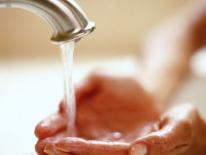
The DOEE wants to ensure that District of Columbia residents are informed about issues concerning the lead safety of its drinking water. Like many other US cities, the District of Columbia has thousands of lead pipes under its streets, known as lead service lines, that carry water into our homes.
On December 1, 2010, the US Centers for Disease Control and Prevention (CDC) released a study that confirms that the presence of a lead service line presents an added risk of lead exposure through tap water. This does not mean that all homes connected to a lead service line have lead coming out of the tap. Instead, it means there is a greater chance of lead contamination occurring. The fact remains that it's very difficult to predict when and where lead contamination is likely to occur, due to the presence of a lead service line.
If you're not sure whether or not your home is connected to a lead service line, you can call DC Water at 202-787-4044 to find out. If you are connected to a lead service line, you can ask DC Water for a water test kit. Because no exposure to lead is healthy, if you're concerned that lead may be in your tap water, it may be safest to only drink filtered water. See below for information about water filters that are effective in reducing lead.
These recommendations apply to everyone, but it's especially important to take precautions if there are young children or pregnant women in the household.
For years, the Washington Metropolitan Water and Sewer Authority (WASA, now known as DC Water) has been gradually replacing lead pipes with non-leaded pipes. There are two types of pipe replacement, partial replacement and full replacement. Partial replacement involves replacing the portion of the lead service line that is under the city street, and on the "public" side of the property line. A full lead service line replacement removes the pipe lengths on both the "public" and the "private" sides of the property line, and is really the only reliable way to minimize the risk of leaded water entering the home plumbing system. Note that lead solder and fixtures containing lead can still be found in the plumbing system inside some homes.
Whenever DC Water replaces lead service lines under the city streets, it encourages affected property owners to take advantage of this work and also replace the lead pipes under their own private property. A full lead service line replacement is ideal, in that this method eliminates the lead pipes altogether and at the same time avoids any temporary increase in lead levels in the water, which has been observed to occur for an indefinite and possibly prolonged period of time after a partial pipe replacement. In fact, the December 1, 2010 CDC study also found that a partial pipe replacement does not reduce the likelihood of lead contamination from the remaining lead pipes. The cost of lead service line replacement under private property in the District of Columbia is typically about $2,000 - $3,000.
If you live in a home that has recently experienced a partial pipe replacement, it is recommended that you call DC Water at 202-787-4044 to request a water test to determine if your water contains lead.
Aerators, Water Filters and Water Testing
In addition to lead pipe replacement, to reduce your risk of exposure to lead in tap water you should periodically remove and either replace or thoroughly clean your faucet's aerator. The aerator is a filter at the tip of your faucet where small particles of lead and other metals can get trapped. If you want to minimize your risk of exposure to lead, DOEE recommends use of a water filter that has been demonstrated to be effective for lead reduction. The standard-setting organization called NSF International provides a list of water filters it has found to be effective for lead reduction.
Finally, if you have or suspect that you may have elevated levels of lead in your tap water, do not use the unfiltered water for drinking or cooking purposes, and especially do not use it to mix formula for infants. (The US Environmental Protection Agency [EPA] has established an "Action Level" for lead in water, at 0.015 mg/L, the equivalent of 15 parts per billion. It's important to note that this is not a "health-based" standard, and that there is no known "safe" level of lead.) To request a lead test of your home's tap water, call DC Water at 202-787-4044. DC Water can also tell you if your home is likely to be connected to a lead service line or not.If you suspect your child may have been drinking lead-contaminated water, DOEE recommends that you ask your child's doctor for a blood lead test right away. For a child under the age of six, the CDC has confirmed that a blood lead level of 5 micrograms of lead per deciliter of blood or greater is an indicator of an unusual lead exposure problem, one that needs to be addressed. If a child who lives in the District of Columbia is found with an elevated blood lead level, DOEE will follow up with professional staff attention for the affected family, including a thorough environmental investigation to identify the source(s) of lead exposure for that child. For additional details, please read Lead Screening Guidelines [PDF].
For more information about lead pipes, and to see a list of District of Columbia streets where lead pipe replacements are being planned as well as where they have already occurred, please visit DC Water.

